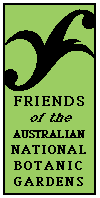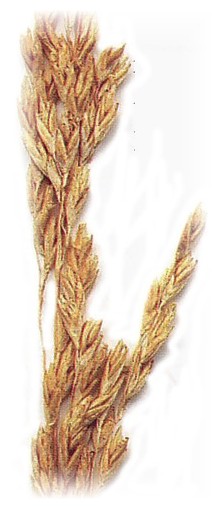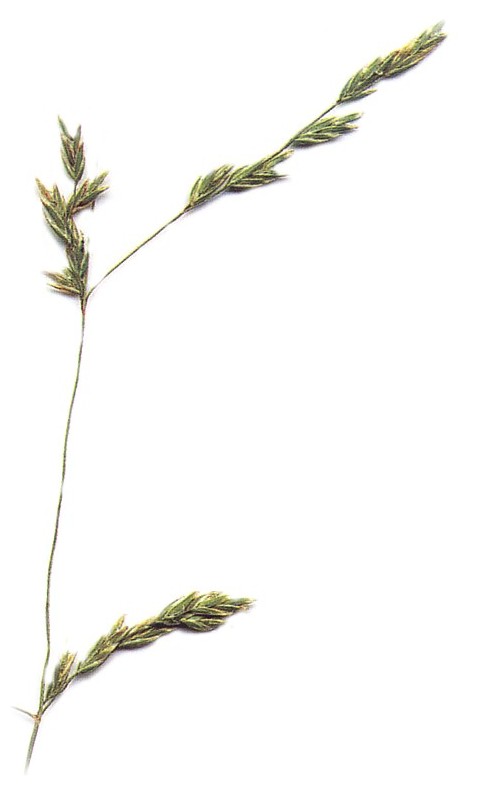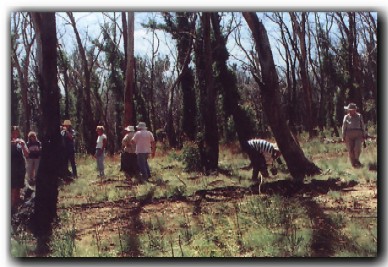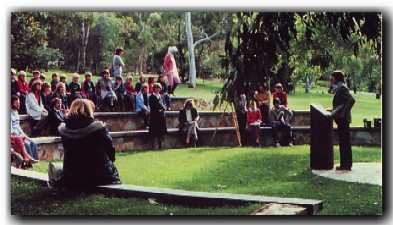Trees, trees,
beautiful trees;
Plant them and help them grow
Care is repaid by cool green shade.
Oh trees, beautiful trees.
Who
else learnt that little song in primary school?
The Eucalypt Lawn
(Sections 34, 35 and 300) in the Australian National Botanic Gardens
has over 100 species of Eucalyptus planted, and they all have
stories to tell.
Belonging to the
family Myrtaceae, the genus Eucalyptus was named in 1788 by the
French botanist Charles Louis L'Heretier de Brutelle (1746 - 1800),
from the Greek eu well and kalyptos covered, referring
to the cover (operculum) of the flower buds. There are over 700 species,
with more than 3000 of these occurring in south-eastern Australia.
While not many
trees will be flowering at this time of year, there remain of interest
the textures and colours of the bark, of which there are several categories,
i.e. smooth, scribbly, powdery, stringy, box, tessellated, minniritchi
and ironbark.
Australian Aborigines
use various species of eucalypts for medicines and as food. The roots
of some can be tapped for water, the bark used for shelter, paintings
and for canoes, and the wood used for implements and weapons.
Economically, the
timber is used for wharves, bridges, boat building, railway sleepers,
fences, housing, furniture, musical instruments, veneers, pulp and fuel.
Essential oils for pharmaceuticals and perfumery are distilled and the
honey industry makes great use of Eucalyptus flowering.
One of the earliest
plantings in the Eucalypt Lawn was in 1949 with Eucalyptus paniculata
(Grey Ironbark) with hard, dark grey, deeply furrowed bark (located
at the top of Section 34).
Also at the top
of the lawn is the Nancy Burbidge Memorial Amphitheatre, opened in 1980
to commemorate her life and work in botany. Not only did Nancy establish
the Herbarium Australiense and become director of the Flora of Australia
Project, but also her love of the Australian bush led to her becoming
a foundation member of the National Parks Association of the ACT in
1960 and campaigning to have areas of the ACT protected, thus the declaration
of Namadgi National Park.
I haven't made
a map of the eucalypts I mention below, but if you zigzag down the lawn,
you'll find them and other interesting discoveries along the way.
To the left of
the amphitheatre, is the flaking, mottled, yellow-brown bark (like jigsaw
puzzle pieces) of E. michaeliana (Hillgrove Gum). Its range is
restricted to Mt Barney National Park in Queensland and in NSW to Wyong,
Hillgrove and Enmore areas. It is currently in flower. It was named
after Reverend Norman Michael (1884 - 1951), a Queensland minister,
who had a life-long interest in the flora of Queensland and collected
extensively.
E. citriodora
(Lemon-scented Gum) was planted in 1954. Its natural distribution
is in eastern Queensland. The bark has a pink and grey marbled
appearance, smooth and powdery, then sheds in curling flakes.
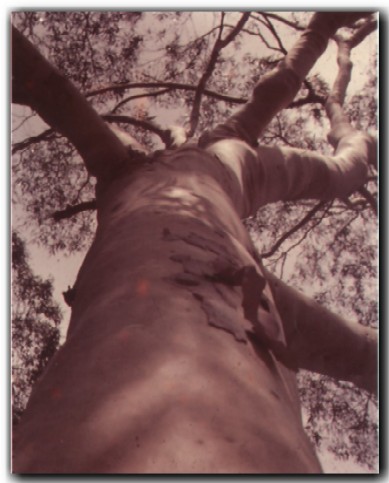
E.
citriodora (Lemon-scented
Gum)
Photo by G. McEwin
E. Pulverulenta
(Silver-leaved Mountain Gum) is straggly, usually a mallee, with smooth
bark, but often with ribbons of old bark hanging from stems. On this
tree the rusty brown bark is splitting open to reveal the smooth yellow-green
new trunk. This is a local species.
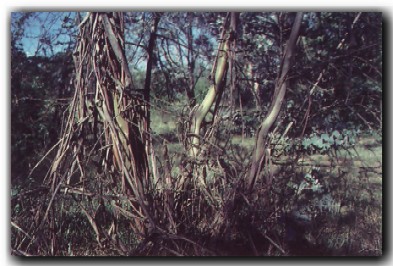
E.
pulverulenta
(Silver-leaved Mountain Gum)
Photo by Brooker and Kleinig
Far right is e.
bancroftii (Bancroft's Red Gum) with mottled tan-grey bark, planted
in 1954, and named after Dr Thomas Lane Bancroft (1860 - 1933), a Queensland
physician with a special love of botany, zoology and entomology. He
tasted over 1,000 north Queensland plants and tested 150 of these, studied
the biology of Australian mosquitoes and gained international recognition
for his work on the Queensland lungfish.
Three big, beautiful
E. saligna (Sydney Blue Gum) with pinky, blue-grey smooth bark
were planted in 1963.
E. watsoniana
(Large-fruited Yellowjacket) from southeastern Queensland has bark that
is orangy-yellow to brownish-yellow, rough and flaky. This species is
distinguished from other yellow bloodwoods by having the largest buds
and fruit.

E.
watsoniana (Large-Fruited
Yellowjacket)
Photo by Murray Fagg
Cross the bitumen
road to Section 35.
A trunk with a
short stocking, smooth and creamy-white, is that of E. benthamii
(Camden White Gum), with a restricted occurrence west of Sydney and
on the flats of the Nepean River. Dr George Bentham (1800 - 1884) worked
at Kew Gardens, England, and examined and classified flora sent to him
which were included in his great work Flora Australiensis. He
never visited Australia.
Behind E. benthamii
is E. bosistoana (Coast Grey Box) occurring on coastal planes
and nearby ranges from near Sydney southwards to eastern Gippsland in
Victoria. Joseph Bosisto (1824 - 1898) was a pioneer pharmacist in Australia
and Mayor of Richmond, Melbourne, where his large business manufactured
essential oils, particularly those of eucalypts.
E. eximia
(Yellow Bloodwood) was planted in 1962 and occurs on coastal hills from
Nowra to the Hunter Valley region. The bark is rough, tessellated, yellow
to yellow-brown, soft and flaky (like eczema). It is the only Yellow
Bloodwood occurring in NSW noted for its curved leaves.
E. baeuerlenii
(Baeuerlen's Gum) occurs at Wentworth Falls in the Blue Mountains and
west of Batemans Bay between Mt. Budawang and Sugarloaf Mountain and
in the Deua National Park west of Moruya. William Baeuerlen (1845 -
1891) was a collector of Australian plants and with Gertrude Lovegrove
published one of the first books on wildflowers in Australia, Wildflowers
of NSW, 1891. He discovered E. baeuerlenii near Braidwood,
NSW.
In the early 1990's
the water usage in the Gardens was assessed and in order to reduce consumption,
part of the upper Eucalypt Lawn was turned into Section 300 where many
mallee eucalypts are planted.
Enjoy your stroll
through this tranquil part of the Gardens.

